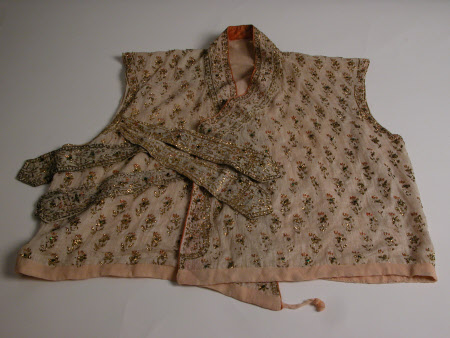Waistcoat
Category
Textiles
Date
1745 - 1767
Materials
Cotton, silk, gilt and beetle wing cases (elytra)
Measurements
600 mm (L)
Place of origin
Mughal Empire
Order this imageCollection
Powis Castle and Garden, Powys
NT 1180734
Summary
Muslin waistcoat made from the bodice portion of an 18th-century jama, unknown maker, South Asia. The original attached sleeves and skirt of the jama have been removed and reformed as a coat and sash (NT 1180735). Jama owned by Robert Clive (1725-74) and later worn as a waistcoat by Ella Rathborne, 5th Countess of Powis (1890-1988) in the 1950s.
Full description
The bodice portion of a jama (a style of garment worn by men in South Asia from the 16th to 19th centuries) in loosely woven white muslin with a repeating sprig in gilt foil, orange floss silk and beetle wing cases (elytra). The original sleeves and skirt of the jama have been removed. Further examination is needed to establish whether the remaining bodice was re-tailored to be worn as a woman’s waistcoat, or worn as a waistcoat without re-tailoring beyond the removal of sleeves and skirt. This jama is probably the one described on 30 April 1774 in an inventory of 'Jewels sent to Mr Cleaveland [Saville Row] with an Indian Dress': "Two short Jammas, Two long Do. One white with Gold Sprigs, a Gold sash, a White Do., Three long narrow pieces, One short broad Do. (To form into a Turban)." If so, the garment belonged to Robert Clive (1725-74) and was presumably acquired by Clive during the years he lived in South Asia (1744-53, 1755-60 and 1765-67). Clive certainly wore South Asian clothing, travelling in 1766 through what is now Bangladesh with a jama, pyjamas (trousers), turban, shawls and sash in his luggage. (Hazzard, p. 267). He also received sets of ceremonial robes from the rulers Mir Jafar (c. 1691-1765), Najmuddin Ali Khan (c. 1747-66) and Alamgir II (1699-1759). The white jama with gold sprigs described in the 1774 inventory was sent to the artist Benjamin West, along with other jamas owned by Clive (BL MSS Eur G37/84/6). Benjamin West (1737-1820), who never travelled to South Asia, may have used this clothing to inform his painting, ‘Shah 'Alam, Mughal Emperor (1759–1806), Conveying the Grant of the Diwani to Lord Clive, August 1765’, which is now at Powis Castle. (Dalrymple, p. xxviii-xxix). The jama was altered in the 1950s for Ella Rathborne (1890-1988), the 5th Countess of Powis from 1952-88, to create a coat and sash (NT 1180735), and this waistcoat. (Archer et al., p. 100). Rathborne was painted in the dress in c. 1954 (NT 1185518).
Provenance
Acquired by Robert Clive in South Asia and mentioned an inventory of his possessions, 1774. Thence by descent to Edward Henry Herbert, 5th Earl Powis. Accepted by HM Treasury on 21st March, 1963 in lieu of tax and conveyed to National Trust ownership on 29th November 1963.
References
2019 Dalrymple: W Dalrymple, The Anarchy: The Relentless Rise of the East India Company, Bloomsbury 2019 Archer, Rowell and Skelton 1987 Mildred Archer, Christopher Rowell, and Robert Skelton, Treasures from India: The Clive Collection at Powis Castle, London, 1987 Hazzard 2023: Hazzard, Kieran, 'The Clives at Home: Self-Fashioning, Collecting and British India' in Coutu, Stobart and Lindfield (eds.), Politics and the English Country House, 1688-1800 (McGill-Queen's University Press, 2023)
